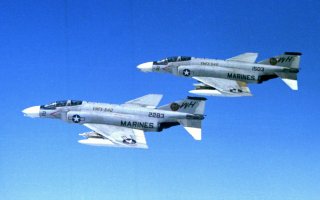More Than Sixty Years Later, the F-4 Phantom Still Roams the Skies
The legendary aircraft was an icon of the Vietnam War.
The Iranian air force in 2009 claimed to operate 76 F-4Ds and Es, and six RF-4s. Tehran has reportedly modified the planes to fire Russian or Chinese air-to-ground and anti-shipping missiles. They still rely on AIM-7 Sparrows acquired second hand.
Likewise, Iran relies on smuggled and improvised spare parts for its F-4s, just like its F-14 Tomcats.
Iranian Phantoms bombed Islamic State targets in Iraq’s Diyala province in December 2014, and they continue to play cat and mouse games with U.S. patrols and drones over the Persian Gulf.
But are souped-up F-4s really equal to fourth-generation fighters? None of these 21st century Phantoms have flown in air-to-air combat — but F-4s Phantoms have engaged in non-lethal dogfights with Greek F-16s on several occasions.
They also tangled with Chinese Su-27s in a 2010 exercise — and according to some reports on the internet won zero to eight.
And if you compare videos of F-4s with wing slats making a tight, 180 degree turn (see 4:25 above) compared to F-15s doing the same maneuver, you will note that they both average seven to eight seconds to complete the turn, even though the latter is purportedly more maneuverable.
This doesn’t prove upgraded F-4s are superior to later designs, of course — but it does show they capable of pulling their considerable weight when compared with fourth-generation fighters.
The Phantom has proven both versatile and adaptable over time. Few of those present for its first flight in 1958 could have imagined that it would remain in frontline service nearly 60 years later.
Sébastien Roblin holds a master’s degree in conflict resolution from Georgetown University and served as a university instructor for the Peace Corps in China. He has also worked in education, editing, and refugee resettlement in France and the United States.
This article first appeared in June 2016.
Image: USMC / Wikimedia Commons

